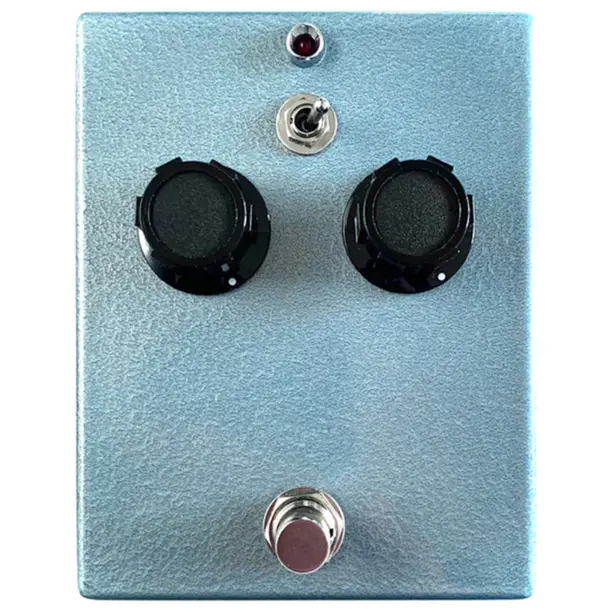
Hailing from New Zealand, the Cunningham Amplification Zonk MK1 is a high quality stompbox paying homage to two legendary fuzzes from the mid-60s: the ultra-rare Hornby Skewes Zonk Machine and the Sola Sound MK1 Tone Bender. This pedalboard edition is hosted in a much smaller case than the original trapezoid one.
The two circuits are very similar, likely variants of the Maestro FZ-1 Fuzz-Tone. This design, which is not a replica, improves on a series of aspects conducive a more modern tone.
Both pedals are known for their chewy attack rich in overtones, and distinctive gating effects, particularly when adjusting guitar volume or attack. The MK1’s input capacitor is 10 times larger than the Zonk’s, allowing more bass and mids through, delivering a full-range, throaty attack. The Zonk, on the other hand, is brighter, tighter, and a little less compressed.
A switch toggles between Zonk and MK1 modes—lower value for Zonk and higher for MK1, with the first cutting better through the mix, and the latter providing a beefier tone.
Below the mode switch, there are the standard Zonk/MK1 controls for Fuzz/Attack and Swell/Level—both pedals utilize different names for the same functions.
Check out how it sounds in the video below.
Cunningham Amps Zonk MKI, Builder’s Notes
Introducing the Zonk/MK1 Fuzz Pedalboard Edition. This version features the same circuit design, component selection and performance of its bigger wedge-shaped brother. Here you get all that tone in a smaller footprint with the addition of a LED indictor and DC power jack (note DC power operation requires an isolated power supply – most modern multi-outlet pedalboard supplies meet this requirement. No daisy chains! The internal battery is included as standard).
Each pedal is optimised for its set of transistors to provide the ultimate fuzz experience. This run uses a trio of premium New Old Stock transistors – Texas Instruments 2N1307 in Q1, Black Glass OC45 in Q2 and Texas Instruments 2G308 in Q3. The Black Glass OC45s are all manufactured by Mullard Great Britain – they’re either branded Mullard, Valvo or Valvo with a German Military sticker over top. The sets are matched for their tonal qualities and how they interact together in the circuit. All are of the highest quality and tested by ear for low noise and great tone.
The Zonk/MK1 pays homage to two legendary fuzz boxes from the early days of loud – the Hornby Skewes Zonk Machine and the Sola Sound MK1 Tone Bender. Both these pedals hail from the UK and came into being during the mid-60s, just as rock n roll was exploding its way onto stages around the world. The circuits are very similar, having most likely borrowed their core design from the first fuzz to really make waves – the Maestro FZ-1 Fuzz-Tone – as used to ultimate effect by Keith Richards on (I Can’t Get No) Satisfaction.
The MK1 Tone Bender and Zonk Machine were beefed up to take the now ubiquitous 9-volt power supply (the FZ-1 runs on 3 volts) and apart from some different component values here and there are largely identical in design. The biggest tonal difference occurs right up front where the MK1 input capacitor is 10 times to size of the Zonk. This translates into letting more bass and mids through the circuit, giving the MK1 a full range throaty attack. The Zonk is brighter, tighter and little less compressed but will happily tear your face off in full flight.
Both have a tactile, chewy attack, loaded with interesting overtones and some tasty gating that’s accentuated when rolling back your guitar volume or softening your attack. Always musical and inspiring to play – these are the types of effect that send you off exploring unchartered sonic territory.
Our versions of the pedals presented here are not intended as replicas – there are amazingly accurate reproductions of these fuzz boxes available if you want something as close as possible to the originals. For this run we wanted to offer something a little different, a best of both worlds experience through a custom-made pedal using the finest components and a no compromise approach to build quality.
The small switch on top toggles between Zonk and MK1 mode (left and right respectively on the switch). A simple but highly effective mod that changes out that first input capacitor – a lower value for the Zonk and higher for the MK1. Also great for matching the pedal to different guitar and amp combinations – Zonk mode will give you more cut, MK1 mode a beefier tone.
Below the mode switch are the usual Zonk/MK1 controls for Fuzz/Attack and Swell/Level – the two pedals used different names but they do the same thing. Use the left control to dial in the sweetspot for the fuzz and the right control sets the overall output of the pedal. There’s some interaction between these and having the Level higher or lower also has an impact on the tone. It’s a bit brighter at lower levels and fattens out as you turn it up. Experimentation is the key here to find where it works best with your setup.
From there the signal runs its course through the classic lineup of germanium transistors, there are three in circuit, dialled in to spew forth all the glorious raucousness these pedals are famous for.
When the completed circuit is dimed up through the workshop test amp and we can’t stop playing – we know it’s ready. The real test of course is how it makes you feel when you plug in and crank it up… We’ll let you be the judge.
All pedals come complete with a custom carry bag, signed and numbered certificate of authenticity and instruction card.






















